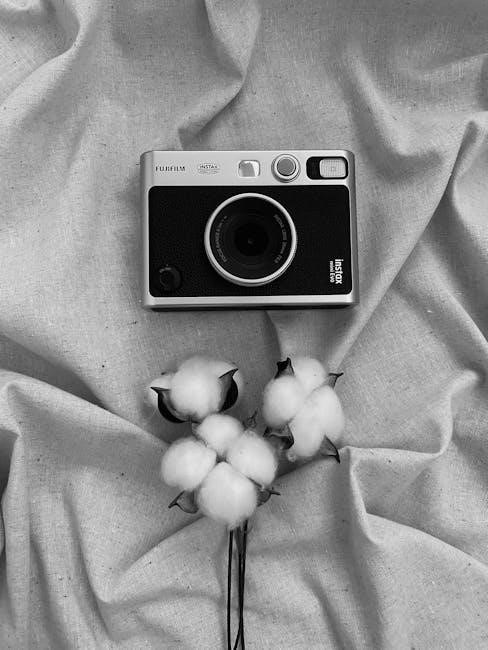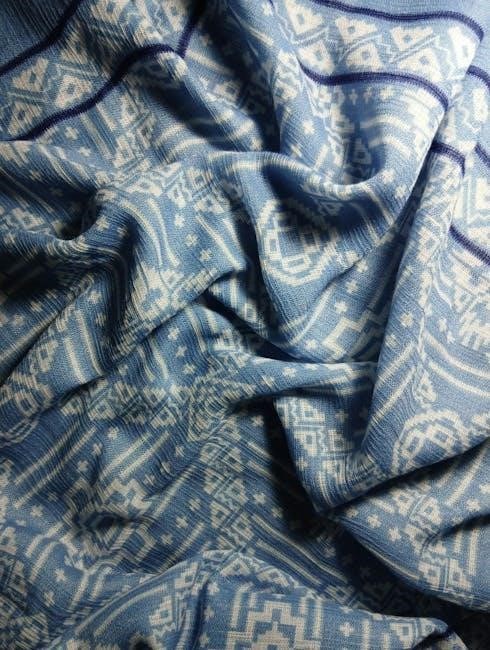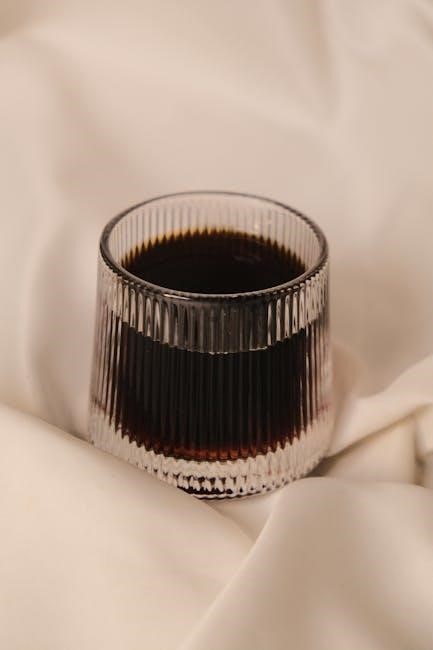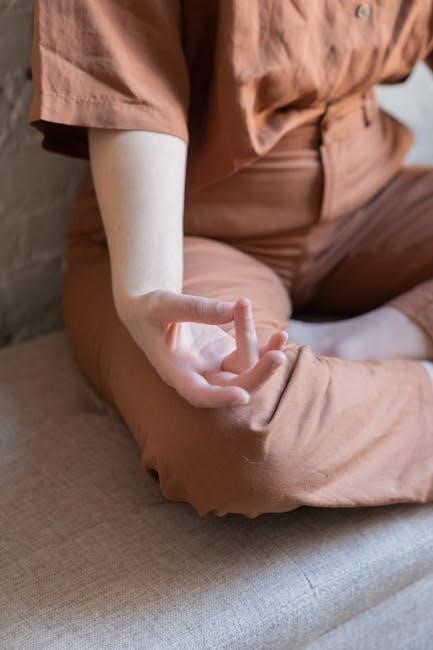Welcome to the ultimate fabric guide! Discover essential insights into fabric types‚ natural vs. synthetic fibers‚ stretch fabrics‚ and sustainable textile practices. Learn how to choose the right materials‚ care for fabrics‚ and explore tools for sewing and crafting. This guide will help you navigate the world of fabrics with confidence‚ whether you’re a beginner or an experienced crafter.
Understanding Fabric Types and Their Uses
Fabrics come in a wide variety of types‚ each with unique properties and purposes. Natural fibers like cotton‚ linen‚ and silk are breathable and ideal for clothing‚ while synthetic fibers such as polyester and nylon offer durability and versatility. Knit fabrics‚ like jersey‚ stretch easily‚ making them perfect for activewear. Woven fabrics‚ such as denim and canvas‚ provide structure and stability‚ often used in upholstery or bags. Specialty fabrics‚ including lace‚ velvet‚ and fleece‚ add texture and aesthetic appeal to projects. Understanding the characteristics of each fabric type helps in selecting the right material for sewing‚ crafting‚ or home decor‚ ensuring the best results for any project.

Natural vs. Synthetic Fibers

Natural fibers‚ like cotton and silk‚ are breathable and biodegradable‚ while synthetic fibers‚ such as polyester‚ offer durability and low maintenance‚ each suiting different needs.
Key Differences and Applications
Natural fibers‚ such as cotton‚ silk‚ and wool‚ are biodegradable and offer breathability‚ making them ideal for clothing and home textiles. Synthetic fibers like polyester and nylon are durable and moisture-resistant‚ perfect for sportswear and outdoor uses. Understanding these differences helps in selecting fabrics for specific projects. Natural fibers are great for everyday wear and eco-conscious choices‚ while synthetics provide longevity and performance. This distinction is crucial for tailoring fabric selection to meet the demands of various applications‚ ensuring both comfort and functionality.
Stretch Fabrics
Stretch fabrics‚ like spandex and knits‚ offer elasticity for comfort and movement. Ideal for activewear‚ lingerie‚ and form-fitting garments‚ they provide flexibility and recovery‚ enhancing wearability and durability.
How to Choose the Right Stretch Fabric for Sewing
Selecting the ideal stretch fabric involves considering your project’s purpose and desired comfort. For activewear‚ opt for high-elasticity fabrics like spandex blends. Knits are perfect for garments requiring a soft‚ breathable feel. Always check the fabric’s stretch percentage to ensure it meets your needs. Pre-washing and drying can help determine shrinkage and recovery. Use appropriate sewing tools‚ such as a serger or stretch needles‚ to maintain elasticity. Test fabric samples before committing to a large project to ensure durability and performance. Proper care‚ like avoiding high heat‚ will preserve the fabric’s stretch over time.

Textile Recycling and Sustainability
Textile recycling reduces waste and promotes sustainability by converting old fabrics into new materials. It minimizes environmental impact‚ supports eco-friendly practices‚ and encourages responsible fabric production and consumption.
Environmental Impact and Recycling Options
Textile recycling plays a crucial role in reducing the environmental impact of fabric waste. The fashion industry contributes significantly to greenhouse gas emissions and landfill waste‚ making sustainable practices essential. Recycling options include upcycling‚ donating unused fabrics‚ and participating in industrial recycling programs. Many organizations now offer textile recycling services‚ transforming old fabrics into new materials. Additionally‚ consumers can adopt eco-friendly habits by repurposing fabrics or supporting brands that prioritize sustainability. Educating oneself about local recycling initiatives and the benefits of fabric reuse can significantly reduce waste and promote a greener future. Every small step toward sustainable textile practices makes a difference.

Fabric Care and Maintenance
Proper fabric care ensures longevity and preserves quality. Wash fabrics according to their type‚ avoid harsh chemicals‚ and dry naturally when possible. Store fabrics in cool‚ dry places to prevent damage. Regular maintenance‚ like steaming or ironing‚ keeps materials fresh. Always pre-wash fabrics before sewing to avoid shrinkage. Understanding specific care requirements for different fibers helps maintain their texture and appearance over time.
Tips for Preserving Fabric Quality and Longevity
Preserving fabric quality and longevity requires careful attention to detail. Always wash fabrics before sewing to pre-shrink them and remove finishes. Use cold water to prevent color bleeding and fabric shrinkage. Avoid using harsh detergents‚ as they can damage fibers. Gently hand-wash delicate fabrics or use a gentle cycle. When drying‚ avoid direct sunlight‚ as it can fade colors. Iron fabrics while they are slightly damp to remove wrinkles effectively. Store fabrics in a cool‚ dry place‚ away from pests and moisture. For delicate or special-care fabrics‚ consider using acid-free tissue paper or breathable storage bags. Regularly inspect stored fabrics for signs of wear or damage. By following these tips‚ you can extend the life of your fabrics and maintain their original quality.


Tools and Notions for Fabric Work
Essential tools for fabric work include sewing machines‚ rotary cutters‚ scissors‚ measuring tapes‚ and sewing needles. These tools ensure precision and efficiency in crafting and sewing projects.
Essential Supplies for Sewing and Crafting

Stocking up on the right supplies is crucial for any sewing or crafting project. Start with a sewing machine‚ which is a cornerstone for efficiency. Rotary cutters and self-healing mats are must-haves for precise fabric cutting. A variety of scissors‚ including dedicated fabric shears‚ ensures you’re prepared for different tasks. Measuring tools like tape measures and seam gauges help maintain accuracy; Don’t forget an assortment of sewing needles‚ threads‚ and zippers to cater to various fabrics and projects. Interfacing and stabilizers are also vital for adding structure to your creations. With these essentials‚ you’ll be well-equipped to bring your fabric ideas to life seamlessly.
Fabric Shopping Guide
Learn how to shop for fabric online with confidence. Discover tips for selecting the right materials‚ understanding fabric descriptions‚ and ensuring quality and accuracy in your purchases.

How to Shop for Fabric Online with Confidence
Shopping for fabric online can be challenging‚ but with the right approach‚ it becomes straightforward. Start by reading detailed descriptions and checking fabric weight‚ composition‚ and stretch. Look for high-quality images‚ preferably on a scale or with a ruler‚ to gauge texture and pattern size. Read reviews from other customers to understand how the fabric behaves in real projects. Ordering swatches is a wise step to ensure color accuracy and feel. Finally‚ compare prices across retailers and factor in shipping costs to make an informed decision. These steps help you select fabrics that meet your project’s needs effectively.
Fabric and Personal Style
Fabrics reflect personal style and lifestyle. Opt for natural fibers for classic looks or stretch fabrics for comfort. Select fabrics that align with your wardrobe and activities for a seamless blend of style and functionality effortlessly.
Matching Fabrics to Your Lifestyle and Preferences
Matching fabrics to your lifestyle ensures comfort and practicality. For active individuals‚ stretch fabrics like spandex blends are ideal‚ offering flexibility. If you prefer a classic look‚ natural fibers such as cotton or silk are timeless choices. Consider your daily activities—durable fabrics like canvas or denim suit busy schedules‚ while delicate materials like lace or chiffon are perfect for special occasions. Climate also plays a role; breathable fabrics like linen are great for warm weather‚ while wool and fleece are cozy for colder months. Aligning fabric choices with personal preferences ensures your creations are both functional and stylish.
